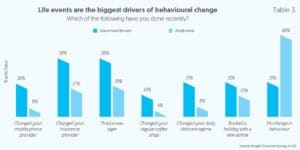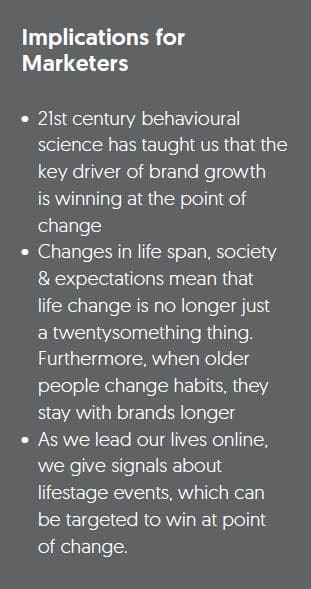One of the biggest drivers of behavioural change is a new life event. Previously most defining changes happened before the age of 35. Now, we are living longer and have more changes throughout life… with profound implications on marketing.
In the 20th century, our 20s were the defining decade of adulthood. It was said that 80% of life’s most defining moments took place before 35.”
If behavioural economics through Daniel Kahmemen’s Thinking, Fast and Slow has taught marketing anything, it is that we are creatures of habit. Once we get into a habit, our brains make it hard to break. So the secret of brand growth is to win at the point of change. One of the biggest
drivers of change in behaviour (see table 3) is life event/lifestage change. This is true across a huge array of categories from automotive, bank accounts, alcoholic drinks to mobile phones and beyond.
In the 20th century, our 20s were the defining decade of adulthood. It was said that 80% of life’s most defining moments took place before 35. Two thirds of lifetime wage growth happened during the first ten years of a career. More than half of Americans were married or were
dating/living with their future partner by age 30. Just think about the brand changes that you went through at key points in your life: becoming a student, getting a new job, starting a new relationship or even divorcing. On this basis, as people went through three lifestage changes (study, work, retirement), targeting twentysomethings made a lot of sense.

The 21st century has seen seismic societal, cultural and technological shifts. This has forced society to evolve from a three-linear lifestage (see table 4) to multi-stage life and an unpredictable future. This has been reflected by the ‘gig economy’, later marriage, older mums and same-sex parents becoming part of the new normal. Increasing lifespan is challenging conventional lifestages. It is estimated that half the babies born in
wealthier countries since 2000 may reach their 100th birthdays (source: Human Mortality Database, 2018).

This increased lifespan makes life a marathon, requiring careful pacing to stay fully engaged, with sufficient resources in terms of money and health to enjoy it. Both Dick Bollies in his book The Three Boxes of Life and How to Get Out of Them and Lynda Gratton & Andrew Scott in their award-winning book The 100-Year Life stressed that the three stage linear trajectory lifestage – education, work, retirement – is no longer relevant. Bollies argues that learning, working, and playing should be part of every day, regardless of our age. While Gratton & Scott believe that for individuals to enjoy the gift of long life, they will have to yield to a multi-stage life that involves repeated cha nges of direction and attention. Material and intangible assets will need upkeep, renewal or replacement. Skills will need updating, augmenting or discarding, as will networks of friends and acquaintances. Earning will be interspersed with learning or self-reflection.
nges of direction and attention. Material and intangible assets will need upkeep, renewal or replacement. Skills will need updating, augmenting or discarding, as will networks of friends and acquaintances. Earning will be interspersed with learning or self-reflection.
In this new world, twentysomethings will no longer have the monopoly on lifestage changes. So it is more important than ever to focus on what matters: the changes in lifestages and events that drive brand behaviour change. As we conduct our lives online, these change
moments are easy to identify, predict and target. In fact, when we think about it, older ‘middle’ aged people might change behaviour less often, but when they do they stay in a habit for longer, so the change has a longer lifetime value.
This means that we shouldn’t simply swap one demographic for another. In this new addressable world we should take the Perennial approach, targeting people prior to or at key lifestage events to win at point of change.
SIGN UP FOR ZENITH INSIGHTS



